The Comprehensive Guide on Banana Plugs: Usage, Benefits, and Installation
In the dynamic world of electrical connectors, banana plugs represent a typical component in ensuring efficient and reliable connections across various electronic devices and systems. These plugs, characterized by their distinctive cylindrical shape with spring-loaded metal leaves, are influential in the realm of audio, video, and testing equipment. This article digs into the comprehensive aspects of banana plugs, examining their design intricacies, advanced features, and their interplay with corresponding components like banana jacks and binding posts. From the basic mechanics of securing a wire to the plug to the innovative features of stackable and retractable designs, the article explores how these connectors enhance usability, safety, and operational efficiency. It highlights the evolution of banana plugs from simple connectors to sophisticated devices capable of supporting complex setups and ensuring high-fidelity connections used for both professional and hobbyist environments.Catalog
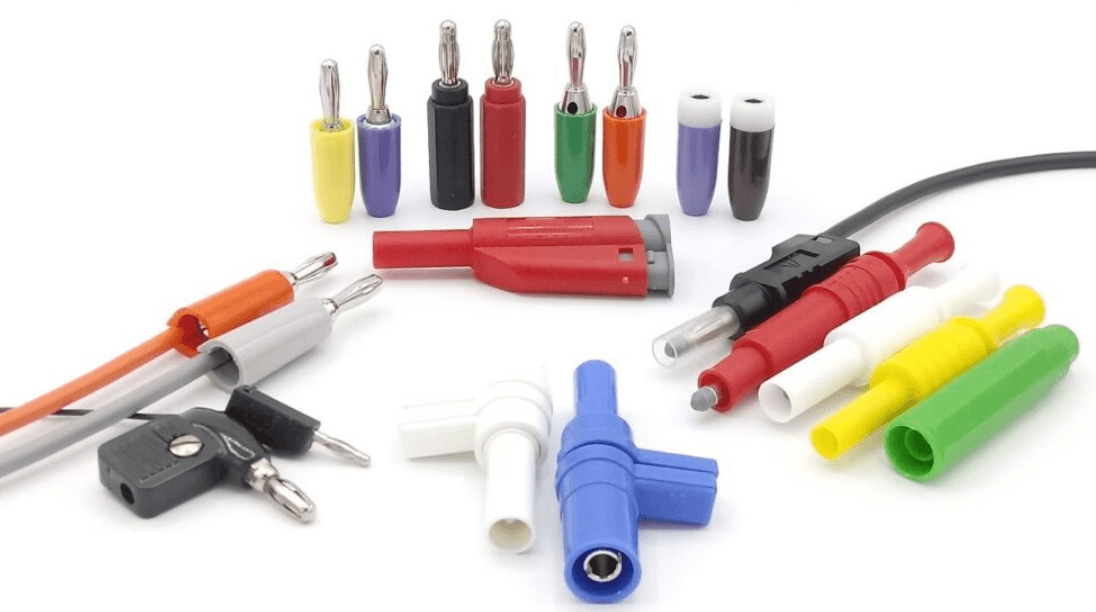
Figure 1: Banana Plugs
Basics of Banana Plugs
Banana plugs are basic single-wire electrical connectors designed to improve the connection of wires to various electronic devices. Known as 4 mm connectors in Europe, they fit different 4 mm socket types, emphasizing the importance of analyzing their specifications for effective use.
A banana plug has a cylindrical pin with carefully designed sprung metal leaves. When inserted, these leaves expand slightly, ensuring a solid, reliable connection. This expansion enhances electrical contact and secures the plug-in place, preventing accidental disconnections.
With a standard 4 mm pin diameter, banana plugs are versatile. You can connect the wire to the plug by screwing, soldering, or crimping, making them suitable for a range of applications, from electronic test setups to audio systems. The rear of the pin is often covered with a partially insulating plastic sheath, adding safety and durability. Banana plugs are designed for easy use with electronic test equipment, speaker wiring, and probe leads. The wire can exit the plug straight, at a right angle, or at a 45-degree angle, catering to different spatial and routing needs.
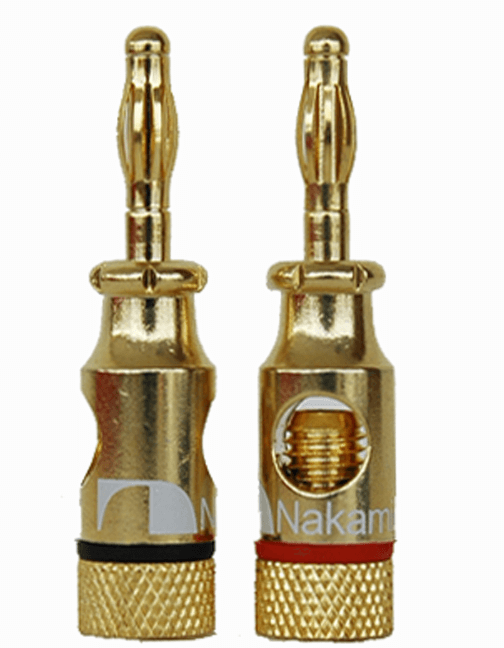
Figure 2: Banana Plug Leaf Design
2. Banana Plug Leaf Design
Banana plugs feature metal "leaves" that perform an extremely important function, giving this connector its name. These leaves are shaped to resemble a banana's curve, which helps achieve a secure connection. When inserted into a socket, the leaves flex outward, increasing the contact area with the socket's interior for a more reliable electrical connection.
Banana plugs typically have either four or nine leaves. The choice between these configurations depends on the specific application needs. The nine-leaf design is especially useful for creating a more secure connection, making it ideal for handling heavier gauge wires or operating in high-voltage environments where safety is dominant.
The nine-leaf design offers a robust grip, reducing the risk of accidental disconnections. This is useful in high-vibration environments or situations where equipment is frequently moved or adjusted. The enhanced grip ensures a stable and safe connection, preventing electrical failures or safety hazards in analytic testing and operational settings. The leaf design directly affects the performance and safety of banana plugs in various electrical applications, from simple home electronics to complex industrial systems.
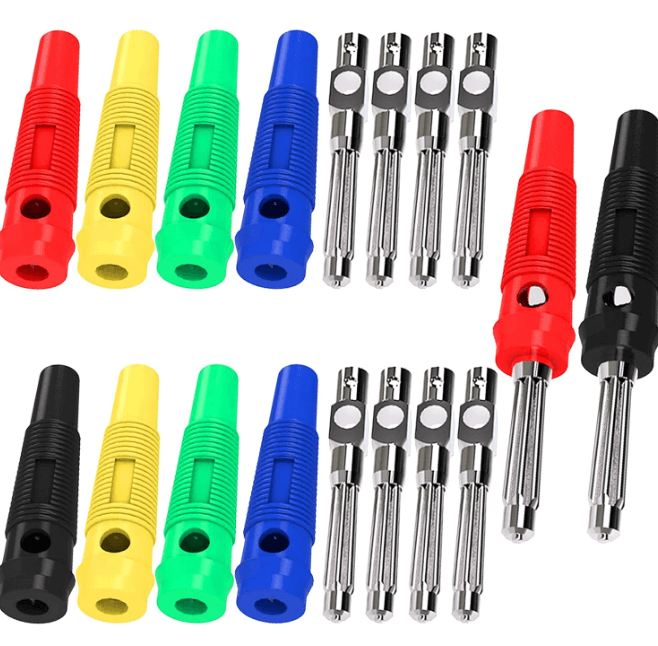
Figure 3: Stackable Banana Plugs
Stackable Plugs in Electrical Connections
Stackable banana plugs are a significant innovation in connector design, enhancing the flexibility of electrical setups. These plugs feature a strategically placed 4 mm hole at the rear, side, or both. This design allows another banana plug’s pin to be inserted directly into the back of the first plug, creating multiple, layered connections.
The stacking feature is especially useful in complex electronic setups where space is limited. By allowing connectors to piggyback on each other, stackable banana plugs reduce the physical space required for connections. This helps to keep the workspace organized and minimizes clutter.
Stackable connections also make it easier to add or remove components from circuits without disrupting the entire system. This is particularly useful during experimental setups, troubleshooting, or when making real-time adjustments. This makes stackable banana plugs ideal for professional labs and hobbyist workstations alike.
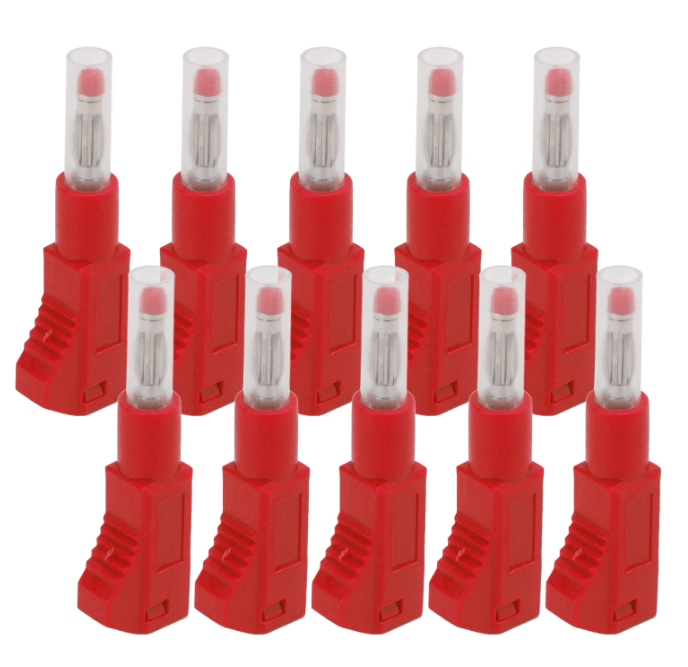
Figure 4: Retractable Banana Plugs
Why Choose Retractable Banana Plugs?
Retractable banana plugs offer advanced functionality and safety in electrical connectors. They feature a spring-loaded shroud that retracts as the pin is inserted into a socket, whether shrouded or unshrouded. This ensures the metal pin is covered when not in use, preventing accidental contact and enhancing user safety.
The retractable shroud is especially useful in environments where exposure to live conductors can pose risks. By automatically covering the pin, these plugs reduce the chance of accidental electrical contact. This makes them ideal for educational settings, research labs, and industrial applications where safety is insistent.
When combined with stackable features, retractable banana plugs offer increased versatility. This combination allows for safe, efficient layering of connections, useful in complex or space-constrained setups. Users can manage multiple connections securely, adapting to various socket types and configurations without compromising safety or functionality.

Figure 5: Binding Posts
Functionality of Binding Posts
Binding posts are settling components in electronic devices, providing versatile connection points for wire terminals. These posts are requisite in various equipment, such as speakers, receivers, amplifiers, and testing instruments. Known as "5-way" or "universal" binding posts, they support multiple connection types, including bare wires, pin connectors, spade connectors, single banana plugs, and dual banana plugs.
Binding posts are designed to work seamlessly with banana plugs, making it easy to establish secure connections. This compatibility is particularly useful in environments requiring quick configuration changes, like audio setups and labs. By accommodating different types of connectors, binding posts offer high flexibility, allowing users to efficiently set up or modify their systems.
The robust construction of binding posts ensures they can handle repeated connections and disconnections without losing their integrity. This durability is basic in professional settings where equipment is frequently reconfigured. The posts' reliability and versatility make them a preferred choice for professionals who need efficient and durable connection solutions.
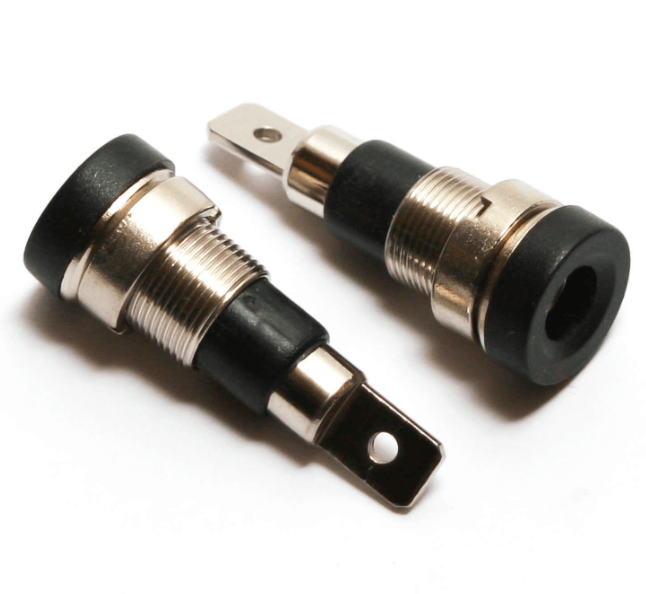
Figure 6: Banana Jacks
How Banana Jacks Improve Your Audio and Video Systems?
Banana jacks are the needed counterparts to banana plugs, serving as receptacles for their insertion. These jacks have various pin configurations at the front end, allowing them to connect with a wide range of electrical devices. This versatility, similar to that of binding posts (a specialized type of banana jack), broadens their applications.
Banana jacks are designed for seamless integration with devices requiring high-fidelity connections, such as audio and video equipment and precision testing instruments. Their support for multiple pin types ensures robust and reliable connections, influential in both professional and hobbyist settings. The interoperability between banana jacks and binding posts enhances their utility.

Figure 7: Dual Plugs and Posts
Impact of Dual Plugs and Posts on Connectivity
Dual plugs and posts offer an innovative solution for setups needing simultaneous electrical connections. Featuring two conjoined banana plugs, these devices are designed for use with amplifiers and speakers equipped with traditional binding posts. This dual configuration reduces the risk of accidental electrical shorts from stray wire strands, enhancing safety and reliability.
The design of dual plugs ensures a more organized and secure connection method. By integrating two plugs into a single unit, the setup becomes neater and more manageable, especially in space-limited environments with multiple connections. This improves both the aesthetic and functional aspects of the setup, simplifying the connection process for quicker adjustments and easier maintenance. Using dual plugs with binding posts creates a robust interface insistent for high-performance audio and testing equipment.
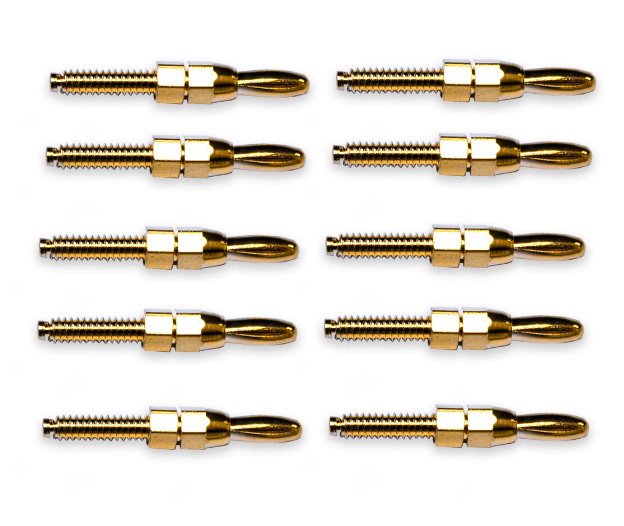
Figure 8: Mini Banana Plugs
Mini Banana Connectors: Compact and Effective
Mini banana plugs are designed for applications requiring smaller connections, offering a compact alternative to standard-sized plugs. Available in 2 mm and 3 mm sizes, they are ideal for portable or space-constrained environments where reducing the electronic component footprint is insistent.
Despite their smaller size, mini banana plugs maintain the functionality of their larger 4 mm counterparts. They ensure reliable electrical connections, providing consistent performance in various applications, from compact consumer electronics to intricate laboratory equipment.
The smaller diameter of mini banana plugs makes them suitable for devices needing high-density connectivity without sacrificing connection quality. This is dynamic for handheld testing devices, miniature audio equipment, and other portable electronics where space efficiency and functionality must coexist.
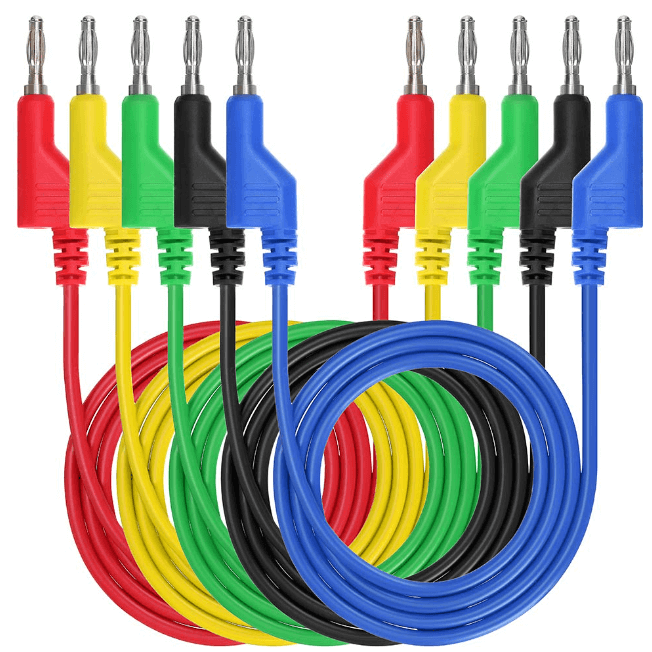
Figure 9: Color Coding
Color Coding in Banana Plugs
Color coding in banana plugs and jacks significantly enhances usability by allowing quick identification and accurate matching of connections. Typically, red and black colors represent positive and negative connections, respectively. This universally recognized color scheme helps prevent errors during setup, ensuring safe and correct connections.
Many manufacturers incorporate color coding into their model numbers, often indicating the component's color with the last digit after a dash. This standardized practice aids in swift and precise identification, helping users easily select the correct part without confusion. Strategic color coding simplifies the setup process and boosts operational efficiency by reducing the time needed to verify each connection.
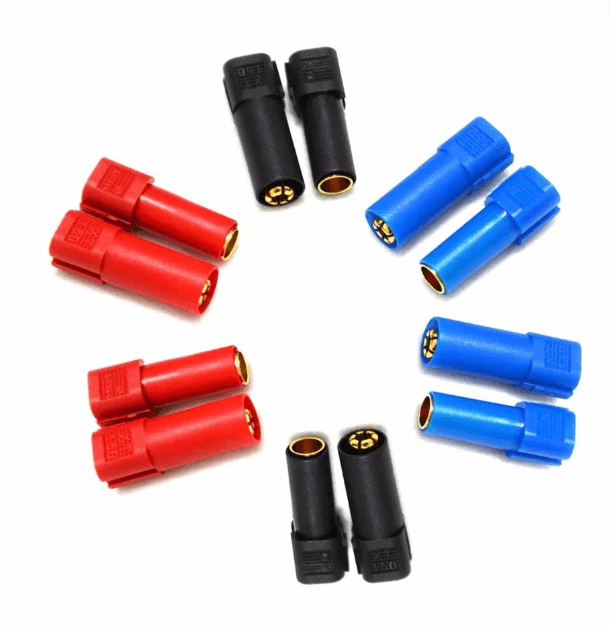
Figure 10: Banana Connector Adapters
Choosing the Right Banana Connector Adapters
Banana connector adapters highlight adaptability in electrical connector technology, providing options that enable seamless transitions between different connector types. These adapters are used for users needing to customize their connection setups to meet specific operational requirements or adapt to changing conditions.
Adapters allow connections between various banana plugs and sockets, as well as pin plugs, coaxial connectors, and other electrical terminals. By facilitating easy and reliable interfacing between diverse connector types, banana connector adapters enhance the flexibility and efficiency of setting up and modifying electronic systems. They are particularly valuable in complex setups, such as mixed-media installations, audio-video systems, and multifunctional testing environments, where different types of connections often need to coexist or be quickly reconfigured. Using these adapters minimizes the need for permanent alterations to existing equipment, preserving the integrity and warranty of expensive devices while still accommodating required customizations.
Mastering the Use of Banana Plugs
Using banana plugs is simple and intuitive, making them accessible for both professionals and hobbyists. The process involves a few straightforward steps that ensure quick and efficient setups without requiring specialized training.
|
Uses of Banana Plugs |
|
|
Preparing the Wire |
First, prepare the wire by stripping
about half an inch of insulation from the end to expose the bare conductor. |
|
Securing the Wire |
Next, secure the exposed wire within the
banana plug. Depending on the plug's design, this can be done by either
screwing it into place or clamping it. Ensuring the wire is firmly attached
is a must for maintaining a stable and reliable electrical connection. |
|
Inserting the Plug |
Finally, insert the banana plug into the
equipment socket. Ensure the connection is tight and secure, as a loose
connection can lead to poor performance and potential safety hazards. |
|
Enhancing Usability and Reducing Setup
Time |
This straightforward process not only
enhances the usability of banana plugs but also reduces setup time. This
makes them ideal for dynamic environments where equipment needs to be
frequently adjusted or moved. |
|
Ensuring Reliable Connections |
By simplifying the method of connecting
wires to equipment, banana plugs reduce potential errors and ensure a robust
connection, supporting the reliable and effective operation of electronic
devices. |
The Pros and Cons of Banana Plugs
Banana plugs offer numerous advantages, especially valuable for DIY enthusiasts who customize their setups. These enthusiasts often tailor their systems with specific cable lengths and connector types, enhancing both the aesthetic appeal and functional integrity of their electronic setups.
• Organizing and Protecting Wiring
The structured design of banana plugs helps organize and protect wiring. This not only improves the appearance but also extends the lifespan and performance of the cables. Properly managed wiring reduces clutter and wear, ensuring a clean and efficient setup.
• Improved Connectivity and Reduced Interference
Banana plugs improve electrical connectivity and reduce signal interference, influential for high-fidelity audio systems and precise electronic testing. Their design ensures a tight, secure connection, preventing wires from becoming loose or disconnected under normal usage.
Conclusion
Banana plugs, with their advanced configurations and diverse applications, stand as a testament to the sophistication of contemporary electronic connector technology. Through detailed exploration of their design, such as the spring-loaded leaves and various attachment methods, the article underscores the reliability and versatility of banana plugs in enhancing electrical connections. The introduction of features like color coding, stackability, and retractability further amplifies their usability and safety across different settings, from professional labs to home audio systems.
In addition, the compatibility with other components like binding posts and the adaptability offered by dual plugs and mini sizes cater to a wide array of electronic setups, making banana plugs requisite in modern electronic configurations. By facilitating secure, efficient, and organized connections, banana plugs not only streamline the setup processes but also significantly reduce the potential for errors and operational inefficiencies, proving their serious role in the optimal performance and safety of electronic systems.
Frequently Asked Questions [FAQ]
1. What is the spacing for banana plugs?
The standard spacing for banana plugs is about 3/4-inch (19 mm) center-to-center. This spacing is compatible with most speakers and amplifiers that accept banana plug connections.
2. Is it better to use banana plugs or bare wire?
Banana plugs offer convenience and a more secure connection, reducing the risk of wire strands fraying or shorting. They make connecting and disconnecting equipment quicker and easier. However, bare wire connections can be equally effective and are more cost-effective if you don’t frequently reconnect your system.
3. Do banana plugs fit all speakers?
Most modern speakers and amplifiers are compatible with banana plugs, but it's needed to check the specifications of your equipment. Some older models or certain brands might only accept bare wire or have different connector types like spring clips, which don't accommodate banana plugs.
4. What is the difference between open and closed banana plugs?
Open banana plugs have a split tip that expands slightly when inserted, ensuring a tight fit and good contact with the binding post. Closed banana plugs, on the other hand, have a solid tip. Open plugs are generally preferred for their secure connection, but both types function similarly in maintaining a good connection.
5. Do you need to strip the speaker wire for banana plugs?
Yes, you need to strip the end of the speaker wire to expose the bare wire when using banana plugs. Typically, about 1/2 inch (12 mm) of insulation is removed from the wire’s end before inserting it into the banana plug and securing it, usually by screwing a small set screw to hold the wire in place.